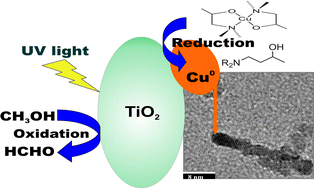Selective photo-deposition of Cu onto the surface of monodisperse oleic acid capped TiO2nanorods probed by FT-IR CO-adsorption studies†
Abstract
A novel, non-aqueous, organometallic route to nanocomposite Cu@TiO2 materials is presented. TiO2

* Corresponding authors
a
Department II of Inorganic Chemistry - Organometallics & Materials, Ruhr-University Bochum, Universitätsstraße 150, Bochum, Germany
E-mail:
roland.fischer@ruhr-uni-bochum.de
Fax: 0049 234 3214174
Tel: 0049 234 3224174
b
Department of Technical Chemistry, Ruhr University Bochum, Universitätsstraße 150, Bochum, Germany
E-mail:
muhler@techem.ruhr-uni-bochum.de
Fax: 0049 234 3214115
Tel: 0049 234 3228754
c
Solar Energy, SE 4, Hahn-Meitner Institut Berlin GmbH, Glienicker Str. 100, Berlin, Germany
E-mail:
chemseddine@hmi.de
Fax: 0049 30 80622434
Tel: 0049 30 80622240
A novel, non-aqueous, organometallic route to nanocomposite Cu@TiO2 materials is presented. TiO2

 Please wait while we load your content...
Something went wrong. Try again?
Please wait while we load your content...
Something went wrong. Try again?
T. Hikov, M. Schroeter, L. Khodeir, A. Chemseddine, M. Muhler and R. A. Fischer, Phys. Chem. Chem. Phys., 2006, 8, 1550 DOI: 10.1039/B512113B
To request permission to reproduce material from this article, please go to the Copyright Clearance Center request page.
If you are an author contributing to an RSC publication, you do not need to request permission provided correct acknowledgement is given.
If you are the author of this article, you do not need to request permission to reproduce figures and diagrams provided correct acknowledgement is given. If you want to reproduce the whole article in a third-party publication (excluding your thesis/dissertation for which permission is not required) please go to the Copyright Clearance Center request page.
Read more about how to correctly acknowledge RSC content.
 Fetching data from CrossRef.
Fetching data from CrossRef.
This may take some time to load.
Loading related content
